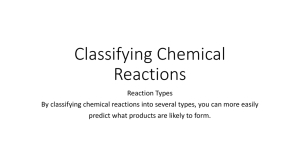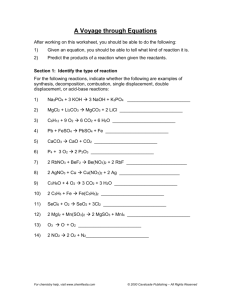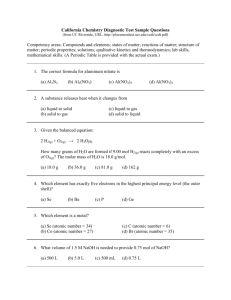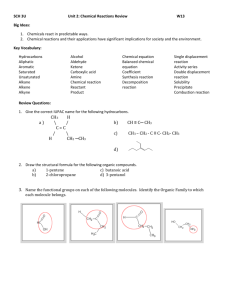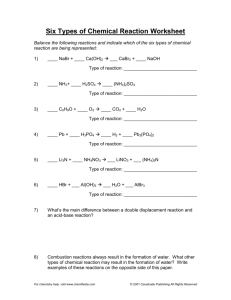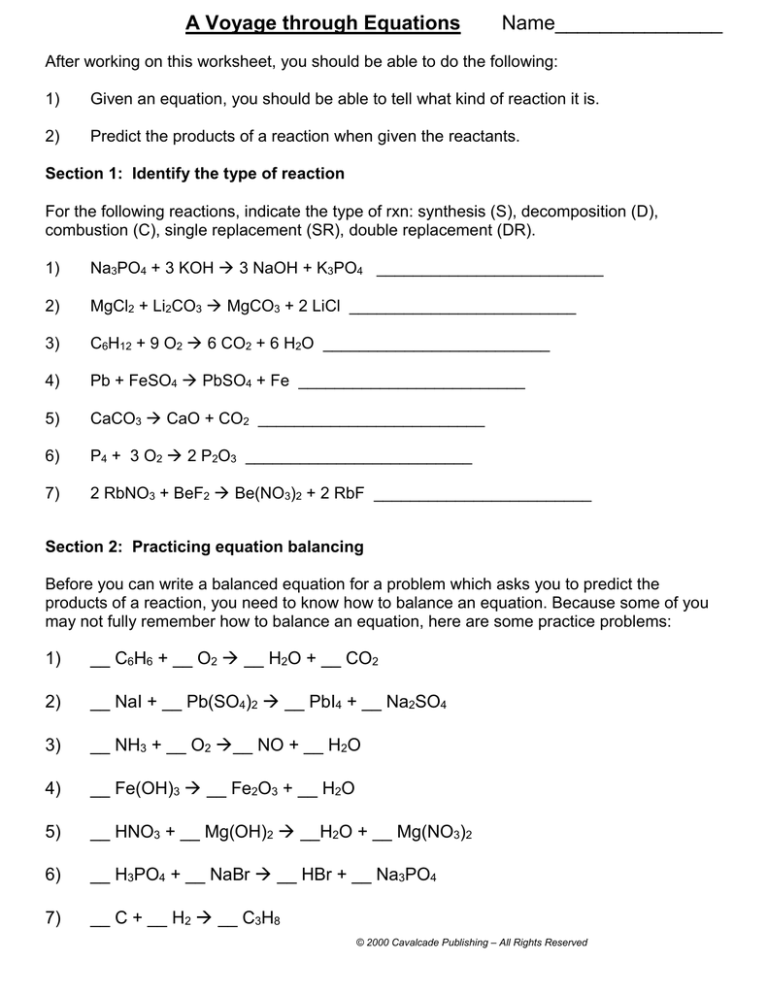
A Voyage through Equations
Name_______________
After working on this worksheet, you should be able to do the following:
1)
Given an equation, you should be able to tell what kind of reaction it is.
2)
Predict the products of a reaction when given the reactants.
Section 1: Identify the type of reaction
For the following reactions, indicate the type of rxn: synthesis (S), decomposition (D),
combustion (C), single replacement (SR), double replacement (DR).
1)
Na3PO4 + 3 KOH 3 NaOH + K3PO4 _________________________
2)
MgCl2 + Li2CO3 MgCO3 + 2 LiCl _________________________
3)
C6H12 + 9 O2 6 CO2 + 6 H2O _________________________
4)
Pb + FeSO4 PbSO4 + Fe _________________________
5)
CaCO3 CaO + CO2 _________________________
6)
P4 + 3 O2 2 P2O3 _________________________
7)
2 RbNO3 + BeF2 Be(NO3)2 + 2 RbF ________________________
Section 2: Practicing equation balancing
Before you can write a balanced equation for a problem which asks you to predict the
products of a reaction, you need to know how to balance an equation. Because some of you
may not fully remember how to balance an equation, here are some practice problems:
1)
__ C6H6 + __ O2 __ H2O + __ CO2
2)
__ NaI + __ Pb(SO4)2 __ PbI4 + __ Na2SO4
3)
__ NH3 + __ O2 __ NO + __ H2O
4)
__ Fe(OH)3 __ Fe2O3 + __ H2O
5)
__ HNO3 + __ Mg(OH)2 __H2O + __ Mg(NO3)2
6)
__ H3PO4 + __ NaBr __ HBr + __ Na3PO4
7)
__ C + __ H2 __ C3H8
© 2000 Cavalcade Publishing – All Rights Reserved
Section 3: Predicting the products of chemical reactions AND balance them!
1)
__ Ag + __CuSO4
Type:___________________________
2)
__ NaI + __ CaCl2
Type:___________________________
3)
__ O2 + __ H2
Type:___________________________
4)
__ AgNO2 + __ BaSO4
Type:___________________________
5)
__ HCN + __ CuSO4
Type:___________________________
6)
__ H2O + __ AgI
Type:___________________________
7)
__ LiBr + __ Co(SO3)2
Type:___________________________
8)
__ LiNO3 + __Ag
Type:___________________________
9)
__ N2 + __ O2
Type:___________________________
10)
__ H2CO3
Type:___________________________
Complete the combustion reaction (react the compound with O2, and your products will be CO2 & H2O)
11) C6H14
12) C6H6
© 2000 Cavalcade Publishing – All Rights Reserved
A Voyage through Equations ANSWER KEY
Section 1: Identify the type of reaction
1)
Na3PO4 + 3 KOH 3 NaOH + K3PO4 DOUBLE DISPLACEMENT
2)
MgCl2 + Li2CO3 MgCO3 + 2 LiCl DOUBLE DISPLACEMENT
3)
C6H12 + 9 O2 6 CO2 + 6 H2O COMBUSTION
4)
Pb + FeSO4 PbSO4 + Fe SINGLE DISPLACEMENT
5)
CaCO3 CaO + CO2 DECOMPOSITION
6)
P4 + 3 O2 2 P2O3 SYNTHESIS
7)
2 RbNO3 + BeF2 Be(NO3)2 + 2 RbF DOUBLE DISPLACEMENT
Section 2: Practicing equation balancing
1)
2 C6H6 + 15 O2 6 H2O + 12 CO2
2)
4 NaI + 1 Pb(SO4)2 1 PbI4 + 2 Na2SO4
3)
4 NH3 + 5 O2 4 NO + 6 H2O
4)
2 Fe(OH)3 1 Fe2O3 + 3 H2O
5)
2 HNO3 + 1 Mg(OH)2 2 H2O + 1 Mg(NO3)2
6)
1 H3PO4 + 3 NaBr 3 HBr + 1 Na3PO4
7)
3 C + 4 H2 1 C3H8
Section 3: Predicting the products of chemical reactions
1)
2 Ag + 1 CuSO4 1 Ag2SO4 + 1 Cu
Type: Single Displacement
2)
2 NaI + 1 CaCl2 2 NaCl + 1 CaI2
Type: Double Displacement
3)
1 O2 + 1 H2 2 H2O
Type: Synthesis
4)
2 AgNO2 + 1 BaSO4 1 Ag2SO4 + 1 Ba(NO2)2
Type: Double Displacement
5)
2 HCN + 1 CuSO4 1 H2SO4 + 1 Cu(CN)2
Type: Double Displacement
6)
1 H2O + 1 AgI 1 HI + 1 AgOH
Type: Double Displacement
7)
4 LiBr + 1 Co(SO3)2 2 Li2SO3 + 1 CoBr4
Type: Double Displacement
8)
1 LiNO3 + 1 Ag 1 AgNO3 + 1 Li
Type: Single Displacement
9)
1 N2 + 2 O2 2 NO2
Type: Synthesis
10)
1 H2CO3 1 CO2 + 1 H2O
Type: Decomposition
© 2000 Cavalcade Publishing – All Rights Reserved


